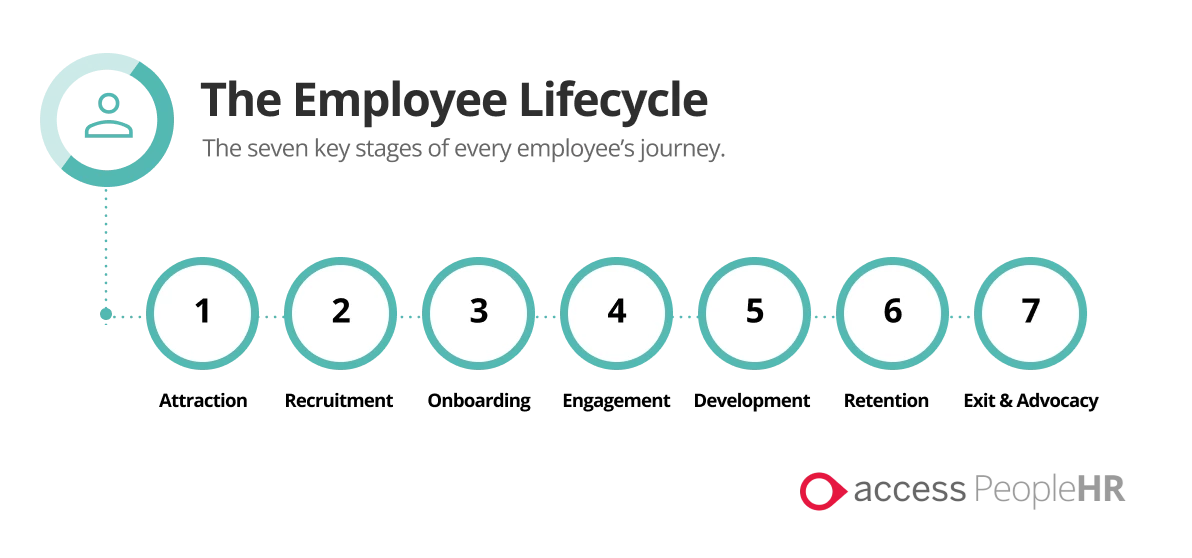
However large or small an organisation, there will be a continual ebb and flow of employees joining and leaving the company. Whether you own a business or work as part of an HR team, it’s important to understand what the employee life cycle is, and how it contributes to motivation, job satisfaction and retention.
If you’re familiar with the customer life cycle, you’ll know the benefits of taking the time to attract, engage with and retain the right people for your brand. The employee life cycle follows the same principles and focuses on nurturing positive relationships and experiences for employees within their role and the overall company culture.
In this article, we’re going to look at what the employee life cycle is in HR, including the 7 stages that make up the employee life cycle model, and how to optimise them for the benefit of your business and the wellbeing of your workforce. When looking at how to optimise your employee life cycle, CIPD learning resources also offer a variety of beneficial tools and insights to support you and your HR department.
What is the employee life cycle?
The employee life cycle describes the key stages that a person progresses through when engaging with an organisation as an employee. The cycle starts from a person becoming aware of the company, continues through their employment, and ends after they leave the organisation.
The 7 stages of the employee life cycle model are:
- Attraction
- Recruitment
- Onboarding
- Engagement
- Development
- Retention
- Exit & Advocacy
 Stage 1. Attraction
Stage 1. Attraction
It’s important to note that the employee life cycle starts before the individual has even applied for a job with the company. In many cases, their awareness may begin with a job listing, although they may have prior knowledge of the company before even considering taking a role with them.
How to optimise the attraction stage
Just like marketing a brand to consumers, HR professionals can optimise the attraction stage by marketing the company to would-be employees. This could be creating a career page, writing regular blog posts about the company, and focusing on social media. Share how your company promotes a healthy work-life balance, exciting events, and webinars you’ve put on, and even day-in-the-life content from current employees.
Stage 2. Recruitment
The recruitment stage covers more than just interviewing candidates. From writing the job advert to supporting new hires post interview and preparing them for their first day of work, there are many distinct stages to the recruitment process that can cover a period of months.
How to optimise the recruitment stage
Optimising your job listings to ensure that they attract candidates who are not only qualified, but also a good fit for your company culture, is a great way to make the most out of the recruitment stage. It’s also important to consider and control biases within the recruitment process and ensure that you have a sound process for providing feedback to unsuccessful candidates. Using a Applicant Tracking System can help you to manage all recruitment steps in one place, and support candidate engagement throughout the entire process.
Stage 3. Onboarding
An effective onboarding process is extremely important to make sure that your new starters feel welcome and comfortable from day one. This is your opportunity to show new employees that you have their best interests at heart and that your company culture is supportive and proactive.
Having a clear onboarding and employee induction procedure in place not only puts new employees at ease, but also reduces downtime for the HR team, managers and colleagues who are providing support.
How to optimise the onboarding stage
The HR team can support the onboarding process by creating a checklist of necessary tasks for line managers to complete with new hires, including setting them up on key software and completing mandatory training.
Encouraging new employees to socialise with their co-workers is also an important part of the onboarding stage, helping them to feel welcome and find their own place in the company. Make them aware of any social activities and online channels, and consider using a buddy system to make sure new hires have someone they can talk to and ask questions.
Stage 4. Engagement
Once the employee is more settled in their role, often around the one-year mark, you need to shift focus to engagement. This stage involves helping employees to feel motivated and appreciated in terms of their work tasks, but also promoting the company culture. Nurturing continual engagement is extremely important for employee growth and development, and helps to improve wellbeing, job satisfaction and productivity.
How to optimise the engagement stage
To keep employees engaged throughout their time with you, encourage them to continue providing feedback, and make sure to continually recognise and reward their achievements. It’s important to be proactive to maintain employee engagement rather than just boosting them once they start to show a lack of motivation. Wherever possible, focus on employee wellbeing and work-life balance to show that you value them as an individual and not just a worker.
Stage 5. Development
Investing in employee training and development not only gives your business access to additional skills in the long term, but also helps to optimise your employee life cycle. Skills that are specific to their job role, as well as soft skills like communication, leadership and giving constructive feedback, will help them to become more successful, well-rounded members of the team. Giving your employees something to work towards and aspire to also supports engagement and retention.
How to optimise the development stage
Optimising the development stage can be as simple as implementing a buddy system for more experienced members of the team to support new employees, or something more structured, such as offering free or subsidised training courses.
Making use of 360-degree feedback is another fantastic way to help employees to identify skills gaps or areas of friction that they need to work on, while appraisal software offers a streamlined, all-in-one solution to manage employee progression. By using HR software to measure employee engagement, you can stay on top of this metric and implement fixes proactively.
Stage 6. Retention
It’s easy to get complacent when an employee has been with you for a period of time and assume that they no longer require any form of ongoing support. However, effective staff retention strategies are a crucial part of the employee lifecycle and shouldn’t be ignored.
Once you’ve invested time and money into training and developing an employee, it’s important to put in the necessary work to retain talent. Failure to do so could mean losing top performers, who could even end up jumping ship to a competitor.
How to optimise the retention stage
Performance reviews are a proactive way to assess how employees are feeling, giving them an opportunity to share feedback or address concerns in an open, non-confrontational forum. It also allows employers to make any necessary adjustments to prevent a lack of motivation from turning into the desire to quit. Leaving extended periods of time between checking in with workers could mean that you miss out on the chance to fix the problem, so make sure to employ a regular schedule to check in.
Stage 7. Exit & Advocacy
Just because an employee is leaving, doesn’t mean that their relationship with the company is completely over. Parting on good terms allows the employee to act as an advocate for the business, sharing positive experiences with others who may be interested in taking a position with you. Maintaining a good working relationship also leaves the door open for the employee to return to the company in the future.
How to optimise the exit stage
Ensure that the offboarding experience is smooth and streamlined to make things easier for both parties. While you might need to spend time looking for a replacement, make sure you continue working to keep employees engaged during their notice period.
Conducting an exit interview can help you to learn from your mistakes and avoid losing talent in the future, as long as you take the time to address any concerns highlighted. The best exit interview questions are those that allow employees to provide valuable and actionable insights to improve the experience of working for your company. Remember to advise employees that they can count on you for a positive reference in the future.
Get feedback from your employees
One of the most effective ways to spot gaps or friction points in the employee lifecycle is to get feedback from employees themselves. While management and HR teams may have the best intentions, nothing beats first-hand experience to determine whether the process is functioning well.
HR professionals should use regular feedback loops to improve each stage of the employee life cycle, using a variety of methods to ensure a holistic overview of employee experiences. As well as basic surveys, implement more interactive methods such as focus groups and dedicated feedback meetings to encourage open discussion.
However, there’s no point asking for feedback if you don’t take action to address any issues that are brought up. Make note of patterns where multiple people are making the same point, and ask for suggestions on how you can improve them.
Whenever you receive feedback from an employee, it’s important to acknowledge and respond to their comments to show that they have been heard. Even if you ultimately choose not to make a change based on feedback, make sure to communicate this to employees, as well as explaining the reasons behind the decision.
Optimising the employee life cycle
As you can see, the employee life cycle contains many distinct stages, and can span anything from a few months to many years. Managing all of these various stages for each employee can be an overwhelming task, especially for small businesses and HR teams. However, taking the time to optimise and streamline the employee life cycle can have huge benefits for job satisfaction, motivation, productivity, and profits.
Using modern HR software gives you access to actionable insights and data across all employee life cycle stages. This transparency makes it easier to spot patterns of failure in particular stages of the employee life cycle that need optimising. You can also automate important tasks to make sure employees are supported throughout every stage of the employee life cycle without manual intervention.
Take advantage of our free trial to find out more about how PeopleHR can support your employees, HR department and business as a whole throughout the employee life cycle.
